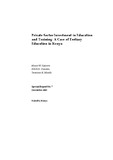| dc.description.abstract | This paper assesses the current status of private sector
participation in education investment and
makes
policy recommendations. A cross-sectional research d
esign was used in this
study.
An
in-depth
descriptive analysis of private sector investment
in
technical
and
university education in Kenya was
carri
ed
out.
A
sampl
e
of
137
pri
v
ate terti
a
ry educati
o
n i
n
sti
t
uti
o
ns was surveyed i
n
2003/
04. K
e
y
informants who responded to the questionnaire includ
ed principals and senior managers of the sampled
institutions.
More than three quarters of
private
institutions
of
hi
gher learning and less than a quarter of commercial
colleg
es
are affiliated
to oth
er institutions eith
er locally
or abroad
. Howev
er majority
of p
r
iv
ate
institutions were single-campus inst
itutions with a considerable numb
er starting their operations after
1990.
Pri
v
ate
i
n
vestment
i
n
terti
a
ry
i
n
sti
t
uti
o
ns has been i
n
creasi
ng rapi
dl
y si
nce 1990. In choosi
n
g the
location, investors considered factors such as the catc
hment area, accessibility, availability of facilities and
infrastructure.
Desp
ite inv
estment in ed
ucation being
a
long
-term
in
vestment, majority of private investors did not own
the land on which business
premises
were
located.
This
was mainly due to high cost of land in areas
considered to be favourable for locating a priv
ate institution, and unsupportive policy and
legal
framework. Most institutions offered soft courses that
were
female-dominated,
as opposed to technical and
engineering oriented courses. Foreign student enro
lment
was
very
low,
though the country is a net
importer
of
education
with
an estimated Ksh 25 billion
being spent annually by Kenyan students abroad.
Sole proprietorship, partnerships and religious or
ganizations were the main investors in
private
education.
Data available was not comprehensive and accurate
enough for the calculation of
net
present
value
and
internal
rate of return that would have enabled a comp
arison of alternative invest
ment choices. However,
a rapi
d i
n
crease i
n
the number of
pri
v
ate terti
a
ry i
n
sti
t
uti
o
ns i
n
the 1990s and af
ter year 2000, and
prevailing optimism on future inv
estment climate by key players
sugg
est that private investment in
tertiary education is profitable. Th
e
study identified barriers to entry into
private education investment to
include poor investment incentives,
inadequate access to credit, access to land,
inadequate
infrastructure,
and
reg
ulations for setting
up
a p
r
iv
ate institution.
In order to enhance private sector investment in
tertiary education, the
legal and regulatory regime
should be reviewed with a view to spelling out the
role of public-private partnerships
in
education
development and making the registration
process
more
e
fficient. Private sector participation in statutory
bodies
that
deal with various aspects of education and
training is important for them to be able to play
their rightful role in education
investment
and
also
to encourage fair practices in the governance of
education and training. | en |

